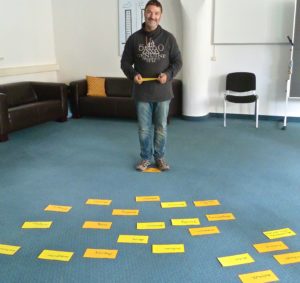Lucas A.C. Derks, a Dutch psychologist explains a breakthrough in applied social science.
‘Imagining, day dreaming, seeing pictures in my minds eye, was from my early childhood, my speciality,’ says 55 years old Derks. ‘In school I was a dreamer - always lost track when a teacher was talking. However, in geometry, geography and drawing I was super. So I finally went to art school. I became a graphic designer. After some time I was mostly painting people in landscapes and selling them. But I considered the life of a professional artist too lonesome, and one is very dependent on journalists and gallery owners as well. I rather wanted todo something that was more intellectually challenging, so I switched to psychology at age 26. At university social psychology became my mayor. In 1977, I read the first book, The Structure of Magic, Vol 1., by Bandler and Grinder: the founders of what later became NLP. That changed my life some more. NLP was science fiction psychology to me. I wanted to do just that.’

Lucas explains how he was one of the few people in the Netherlands who knew about NLP and this made it very easy for him to start teaching it. From 1983 onward he was an NLP trainer. The social panorama came from Derks’ research in unconscious social cognition: How do people perceive and experience others and themselves below the threshold of awareness. The main question was: What is the structure or the map of the social world? Is there a map that we humans use to be able to find our way among people? This map appeared to be a construction in mental space; an unconscious landscape of images of people located around the self. ‘To invent something like the social panorama model you need to be very visual.’ Lucas Derks continues. It deals with images of people. It is three dimensional in nature. You need to be able to manipulate objects and people in three dimensional space.’ ‘When people talk about problematic relationships, it may quickly puzzle the listener; because usually this is complicated and confusing,’ Lucas clarifies the purpose of his model: ‘People express themselves in a profusion of words that are contradictory and expressed in broken sentences. Conclusion: It is very difficult to communicate about relational problems on the verbal level. However, if you regard the same problems as mental images, things become much easier. “One image can tell a thousand words.” The primary value of the social panorama model is that it simplifies the work of coaches and therapists. Now you only need to know WHERE the image of a person is located in mental space in relation to where the self is located. As soon as you know that, it is often quit easy to diagnose the problem and thus find effective interventions.’ The Social Panorama makes it possible to deal with very complicated relationship problems and still be able to manage them. The client is assisted to find his or her own solutions using the structure the social panorama model offers. A question many people ask is: How is this work related to family constellation therapy? ‘It is related in the sense, that family constellation therapy physically moves people around in space. I feel that this needs to be translated by the client into his inner Social Panorama to make it work. The representatives make the therapy more dramatic and surprising. However, you need a group of people, and you need to believe that the representatives and the therapist are reliable. To work with a client in a one to one session, the Social Panorama is more practical since the result can be tested and it comes 99% from the client. The therapist trusts the unconscious social skills of the client. So in the end, the client sees the result as coming from his own competence; not so much as part of external input from the therapist. But family constellation workshops are very spectacular, spiritual and often emotional and that makes them very popular.’
Over the last ten years the Social Panorama went from a small group of people who had knowledge of the hidden world of social imagery to become a powerful tool used by many professionals in the fields of coaching, therapy and management consultancy.